Angled vs Straight Spotting Scope: Which to Choose?
Last Updated on
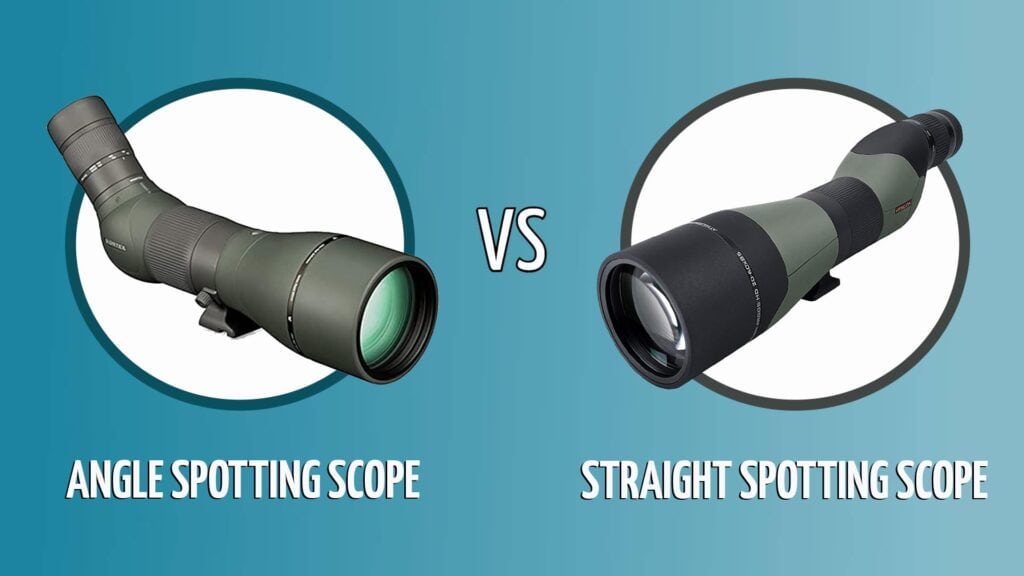
As if there aren’t enough pieces of equipment for you to obtain and understand, you’ll need a quality spotting scope for identifying distant targets. It might seem like a simple purchase on the surface, just pick a scope with enough magnification and get in the field!
But there are more factors to consider. It’s hard to tell just from looking at the two different scopes what kind of performance discrepancies you might find between them. We’re going to break down the differences and help you make an informed decision about which scope is right for you.
Angled Spotting Scope Overview
All it takes is one quick look at an angled spotting scope to understand where it gets its name. While a straight scope is obviously straight, the angled spotting scope curves up towards the eyepiece end.

The curve allows you to change your viewing angle. This can make things a lot more comfortable in some cases. For instance, if you’re sitting down and viewing up a large hill or mountain. Trying to angle a straight scope to view comfortable would be very difficult, but the curve in an angled spotting scope makes it easy.
Similarly, looking downhill will create the same problem. With an angled spotting scope, you can actually turn the scope to adjust the angle, providing many different ways to position the scope and your head for the most comfortable viewing experience.
Applications
Spotting scopes are essentially small, portable telescopes. They’re the perfect tool for viewing anything that requires more magnification than you might get from a set of binoculars.
You’ll often find spotting scopes used for birding, sighting shots with a gun, hunting, surveillance, and more.
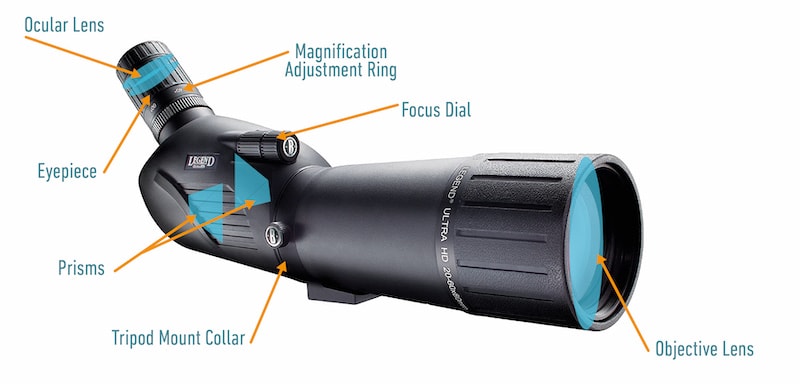
Lens
Spotting scopes have very powerful lenses in order to view faraway objects in great detail. They generally fall between 50mm-80mm in diameter.
Between angled spotting scopes and straight ones, there aren’t many differences in lenses. In fact, many spotting scopes come in a straight or angled option with the same lenses on each, providing the same image with a different level of comfortability.
Magnification
Those big lenses give lots of light and large, clear images, but it’s the magnification that makes it possible to see far-off targets. Spotting scopes can range drastically in magnification, though most fall between 10X and 60x magnification levels. You’ll find similar levels of magnification in angled and straight spotting scopes.
Field of View
In general, the higher the magnification of your spotting scope, the smaller the field of view. Because some spotting scopes can have very high levels of magnification such as 60x, they tend to have smaller fields of view. If you want a larger field of view, you’ll want a scope with lower magnification.
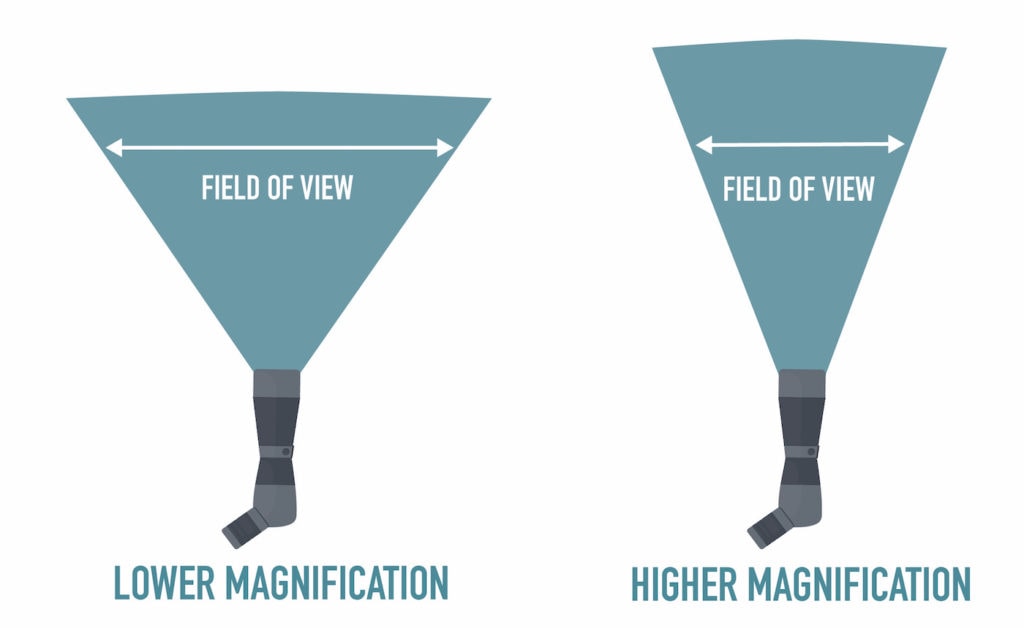
Alternatively, you could switch to binoculars when you want to increase your field of view. But with an angled spotting scope, your tripod won’t be at the right height for the switch. This means you’d have to adjust the height of your tripod to fit your binoculars, which would mean you’d no longer be pointed at the proper place to find your target again quickly.
Pros & Cons of Angled Spotting Scopes
- More comfortable to look through in most positions
- Allows the tripod to sit lower
- Easier to use if sitting and looking up
- Can change the angle for more comfortable viewing
- Have to adjust the tripod to switch to binoculars
- Not as comfortable when laying down
Straight Spotting Scope Overview
As the name suggests, a straight spotting scope is straight. It doesn’t curve like the angled spotting scopes, instead, appearing as a straight tube, like most telescopes you’re probably used to.

A straight spotting scope requires you to raise your tripod to hold the entire scope at viewing height. This makes you more high profile and could cause you to be visible. Also, you’ll generally find that straight spotting scopes are more comfortable when in the prone position. You won’t have to raise your head and look down to view the lens properly.
But they’re not as comfortable for general viewing. You don’t get as much maneuverability out of the straight scope, so you’ll have to find the best viewing angle by repositioning your head.
Applications
You’ll find straight scopes being employed wherever spotting scopes are needed. They’re often the choice for any activity that will have you lying down and spotting for any length of time.
Likewise, straight spotting scopes are often the best choice when you need to quickly acquire your target. The ability to switch your binoculars to your tripod without having to adjust the height of your stand can save precious time. Even better, your binoculars will already be aimed at your target and you won’t have to reacquire your target once you switch.
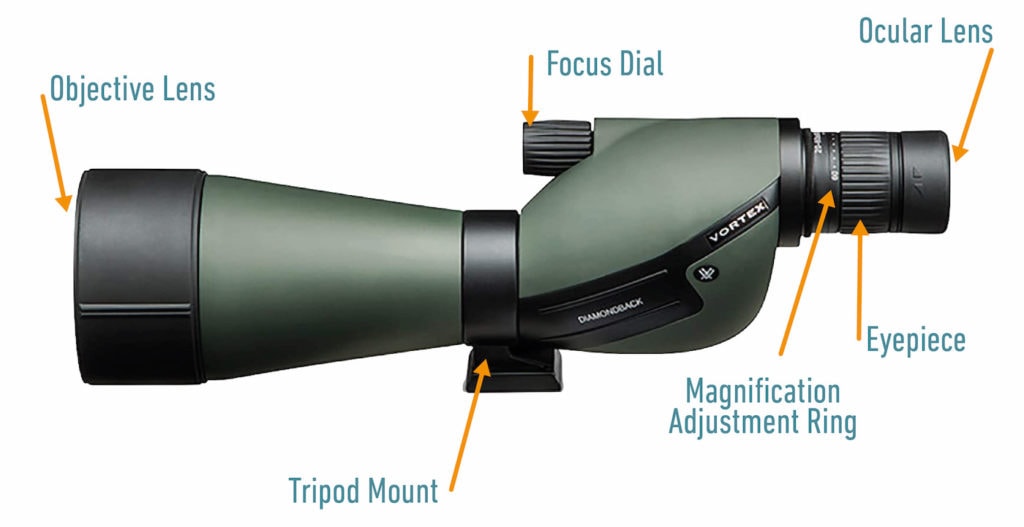
Lens
In general, you will find the same lenses on straight spotting scopes that you’ll find on angled ones. These could be as large as 80mm or as small as 50mm. Any smaller and you’d probably do just as well with a good set of binoculars.
Magnification
Angled and straight spotting scopes tend to have the same levels of magnification. These can vary widely from scope to scope, ranging from 10x up to 60x magnification. You can usually find a straight or angled scope to match the level of magnification you need, so it’s best to make the choice based on how you’ll use your scope.
Field of View
Though angled and straight scopes can have matching fields of view, the straight scopes have an advantage here. You can keep the tripod in the same position and switch the spotting scope for a set of binoculars. This will allow you to keep your binoculars focused on the proper place to reacquire your target and it will save you time messing around with the stand.
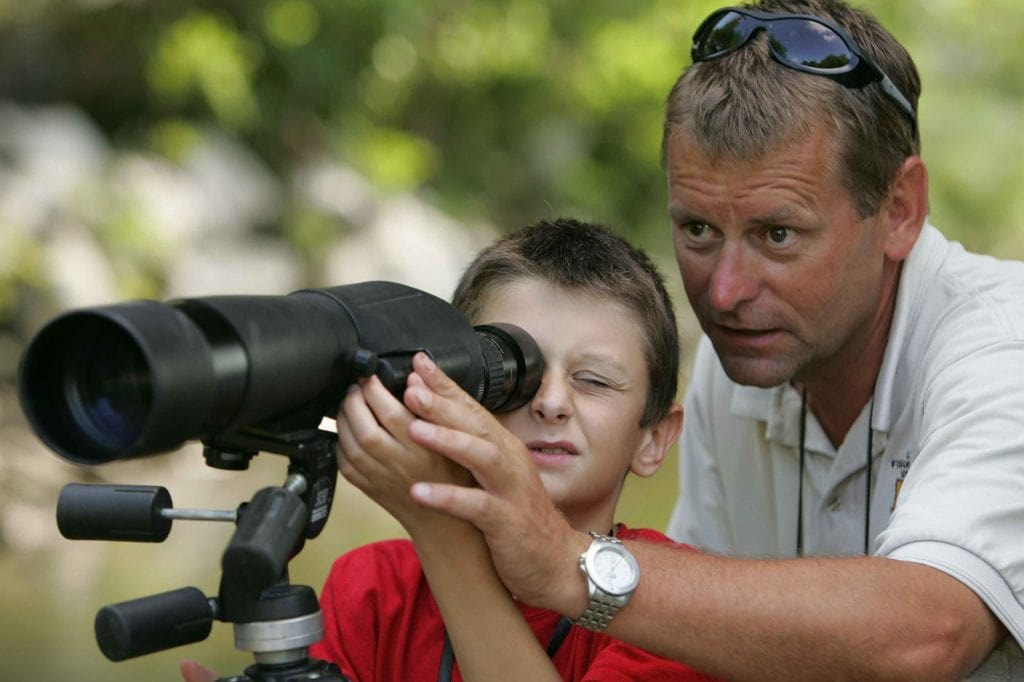
An angled scope won’t allow you to make such quick and easy changes to binoculars. You’d have to first raise the tripod, then attach your binoculars. But then you’d have to search all over to find the area you were just looking at through the scope! Then, if you want to switch back to the extra power of the scope, you’d have to repeat the process in reverse.
Pros & Cons of Straight Spotting Scopes
- When you switch to binoculars, you can keep the tripod in the same place
- Allows for quicker target acquisition
- More comfortable for viewing when prone
- Have to make the tripod taller to use which gives it a less stable base
- The taller tripod makes you more visible
- Not as comfortable for viewing when standing
When to Use an Angled Spotting Scope
If you mainly do your scope viewing while standing or sitting, then you might lean toward an angled spotting scope over a straight one. The curve in the scope will make it more comfortable and easier to view through, especially when viewing for long periods.
User Tip
Angled spotting scopes work much better with a telescoping tripod than freehand.

Because the angled spotting scope is raised on the eyepiece end, you will position the entire tripod lower to get a good view. This can be great when you are trying to keep a low profile to stay hidden, an important factor when spotting live animals.
When to Use a Straight Spotting Scope
If you tend to view from a lying position often, then you might opt for the straight scope instead. When lying down, the straight scope allows for much easier, more comfortable viewing since you won’t have to crane your neck to reach the eyepiece.
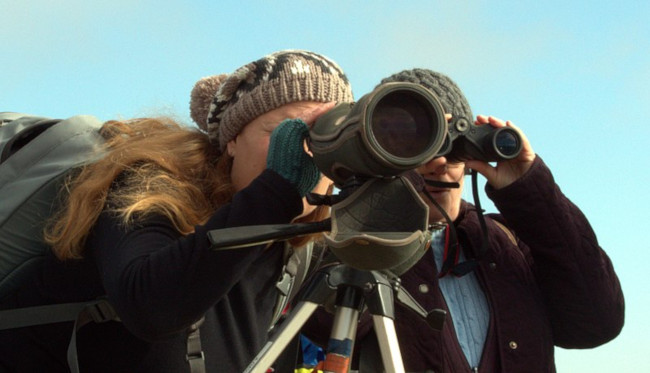
When speedy target acquisition is your main priority, you’ll probably want to pick a straight spotting scope. Because a straight scope has to be mounted at viewing height, you can easily swap the scope out for your binoculars. They’ll be at the proper height and angle to quickly find your target again. Then, you can even switch back with ease.
Price
Many factors need to be considered when you’re purchasing an expensive and important piece of equipment like a spotting scope. Luckily, in this case, price isn’t going to be a factor that you need to give too much thought. Between spotting scopes of the same specifications, angled and straight scopes cost the same. Many scopes are available in both setups, and they’re generally the same price both ways.
Our Favorite Angled & Straight Spotting Scopes
Angled vs Straight Spotting Scope: Which is Right for You?
In the end, neither is right or wrong. It all depends on how you plan to use your scope. They have the same lenses, magnification, and even weigh the same, so the choice lies in how you will view through your scope.
If you use binoculars just as much as you use your scope and you want to quickly change between the two and easily reacquire your target with the same viewing field, then you’ll want to go with a straight scope. Likewise, if you spend a lot of time viewing from a prone position, then the straight scope is your best bet.
On the other hand, if you want to be as comfortable as possible and do most of your viewing while sitting or standing, then the angled scope is a better recommendation, as long as you don’t plan to switch back and forth between your scope and binoculars. The angled scope is also a better choice for when you need to keep a low profile since they allow the scope to be mounted lower than a straight scope.
About the Author Robert Sparks
Robert’s obsession with all things optical started early in life, when his optician father would bring home prototypes for Robert to play with. Nowadays, Robert is dedicated to helping others find the right optics for their needs. His hobbies include astronomy, astrophysics, and model building. Originally from Newark, NJ, he resides in Santa Fe, New Mexico, where the nighttime skies are filled with glittering stars.
Related Articles:
Monocular vs Telescope: Differences Explained (With Pictures)
How to Clean a Refractor Telescope: Step-by-Step Guide
How to Clean a Telescope Eyepiece: Step-by-Step Guide
How to Clean a Rifle Scope: 8 Expert Tips
What Is a Monocular Used For? 8 Common Functions
How to Clean a Telescope Mirror: 8 Expert Tips
Brightfield vs Phase Contrast Microscopy: The Differences Explained
SkyCamHD Drone Review: Pros, Cons, FAQ, & Verdict


